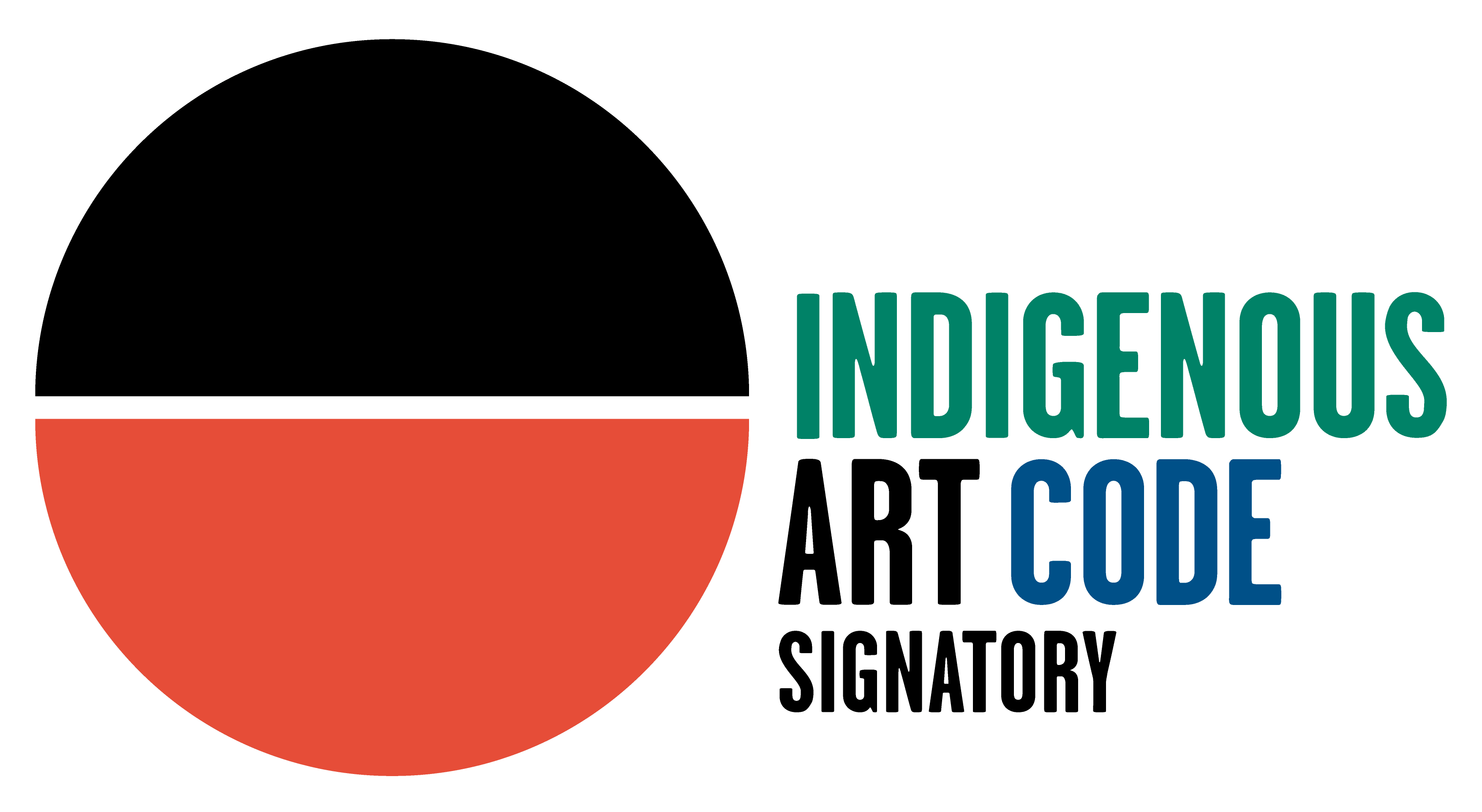Binygurr Wirrpanda Yolngu, b. 1973
51 1/8 x 5 1/8 in
Wurraṉ - Freshwater Darter
This piece is painted in the miny’tji (sacred clan design) of the Dhalwaŋu clan which is one of the eight or so clans belonging to the Yirritja moiety (half) in North East Arnhem land. The sacred diamond design for the Dhalwaŋu clan reflects the patterning of the water streaming from the body of Ancestral Creator Being Barama as he emerged from these waters at Gäṉgaṉ, with weed hanging from his arms.
Today appropriately senior ritual participants wear sacred feathered strings from armbands, their chest painted with the Dhalawŋu design of freshwater. These totemic ancestors of the Dhalwaŋu clan are all associated with this site at Gäṉgaṉ from which all Yirritja creation began. They are seen as embodiments of the disciples or companions of Barama and himself. Black and white dots also representing the wake of the swimming tortoise.
The manifestation of Barama is the long neck tortoise and chief totem for the Dhalwaŋu - Minhala. His disciple is Dhakawa - freshwater crayfish. Another Dhalwaŋu totem is Garkman (frog). It was in a period called Wangarr, the world creation drives of the first mornings, when the Ancestral Beings came to country to give lore and title for the land and its people. The Yolŋu world is based on a duality, of two moieties of equal status that integrate through a complex system of kinship. Clan groups in this area known as Miwatj country belong to either the Yirritja or Dhuwa moieties. Barama came to Gäṉgaṉ from the saltwater country of Blue Mud Bay to emerge from the waterhole named Gulutji with the intention of establishing his law amongst the people there of that time. These original Dhalwaŋu referred to as the Banatja were said to be led by Galparimun who received council from Barama. A third player of law in these times was Lanytjaŋ who walked to Gäṉgaṉ meeting up with Barama.
Barama brought with him to Gaṉgaṉ the hard wood raŋga (sacred objects) that had instilled in them the sacred knowledge pertaining to his law. Also on his body he had the marks left by the waters from where he had come, the sacred miny’tji that was later to become the sacred clan designs for the Yirritja moiety. His staff is a motif shared with his two brothers.
Barama had with him the knowledge of a highly sophisticated system of kinship mapping out associations between clans, country, individuals, all things physical and metaphysical, laws that govern these associations and ritual that included sacred song and dance to ensure its maintenance and miny’tji to claim title to land effected by specific events taking place during these times.
This deep seated knowledge is held today in propriety by the most senior within the clan and safeguarded by Djungaya oraretakers of an appropriate kin of the other moiety. The philosophies of ancient law are ‘graded’ into differing levels of meaning that is progressively divulged to the Yolŋu as part of age grading. The deepest of knowledge is found in the inner most sanctums of Yolŋu society and kept secret. Barama is said to be the most powerful of the Yirritja Creator Beings as it was he who brought to the country the law and its associate iconography, paraphernalia and power. Council between he, Galparimun, Lanytjaŋ and other mythical old men organised for Galparimun to travel south towards Rose River and Numbulwar and Lanytjaŋ to travel north towards Yirrkala and then west to Milingimbi to distribute the sacred objects brought by Barama and the paintings to the Yirritja. The actions of these Ancestors under Barama’s instruction left a balanced system of living for the Yirritja that could coexist with the Dhuwa.
Before they went the sacred Ŋarra ceremony for the Dhalwaŋu was performed on the Yalandu ground at Gäṉgaṉ. The Ŋarra ceremony focuses on clan identity - the Dhalwaŋu had to be given theirs. The miny’tji that encompasses this painting are believed to be those handed to the Dhalwaŋu by Barama so cannot have direct reference to any other clans. An array of events that were to become Barama’s law for the Dhalwaŋu and ultimately for the Yirritja side of the world are manifest in these designs and are illustrated with the careful placement of iconography.
For the Dhalwaŋu there is no dispute that their people are the only people to have the required intimate knowledge of this country Gäṉgaṉ, therefore the responsibilities of ownership must be with the Dhalwaŋu. Where Galparimun remained faithful to this edict, Lanytjuŋ after reaching Milingimbi openly revealed his power and knowledge eliciting jealousy and angering Barama. Lanytjuŋ was killed, such is traditional punishment, his mortuary ceremony followed where his spirit was seen to go into a paperbark tree. A rolled wad of paperbark was made by the ceremonial participant.
One of the metaphorical overviews of this work is the union between the different subgroups of the Dhaḻwaŋu clan in the ancestral cycle of regular fishtrap ceremonies they join together in celebrating. These gatherings are ceremonial but also social and educational.
The sacred diamond design generally refers to the waters around Gäṉgaṉ but the triangles also show the structure of the fishtrap made during Miḏawarr (early Dry Season) with Rangan (paperbark) and wooden stakes. This is the Buyku or fishtrap area which is ‘company’ land (ie. shared by all the people who live by/sing the river). The Dhalwaŋu and allied groups who participate in this song cycle and fishing activity are hunting Baypinŋa (Saratoga) as does the Gany’tjurr (Reef Heron) which they identify with as the archetypal Yirritja hunter.
This also gives reference Wurran the diver duck or the freshwater Darter, referenced in its natural form on top of the diamond pattern. This ancestral totem for the Dhalwaŋu clan travelled over Dhalwaŋu estates following the sacred freshwaters affected by the original creators. Wurran is seen as a metaphor for an agent in death therefore also of life. From the sacred waters of Gäṉgaṉ, Baypinŋa the Saratoga are taken by Wurran who picks the bones clean. In traditional Yolŋu society the last rites of mortuary that have the soul returned for rebirth can only be assumed when the bones have been cleansed of any tissue.
This is an honoured role for the child, mother or mother’s mother kinship relations of a deceased. The Baypiṉŋa are normally cooked in a termite mound ground oven (Gundirr) with sheets of paperbark to trap the heat. This is also a metaphor for the initial burial prior to bone cleansing that a deceased Yolŋu person undergoes prior to the placement of the bones in a Larrakitj, or hollow log.


